| |
| |
INDO-AMERICAN ARTS COUNCIL
In collaboration with
Battery Dance Company's 32nd Annual Downtown Dance Festival
presents
Erasing Borders Festival of Indian Dance : Outdoor Performances
|
|
August 15th, 2013. 12 noon – 2 pm
Battery Park Stage, Great Lawn, (between the Carousel and the Turkey Garden), NYC.
|
| Aug 15, Thursday @ Battery Park, NYC. 12 noon - 2 pm |
| |
| Introduction by Aroon Shivdasani, IAAC Executive & Artistic Director, & Jonathan Hollander, Artistic Director Battery Dance Company |
| |
| Rajika Puri: Narrator ('carrier of the thread' or Sutradhar) |
| |
| Balagopala Tharangam |
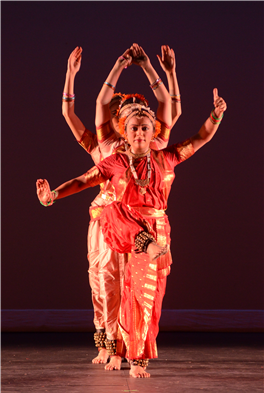 Dancers: Samarpita Bajpai, Kirstie McDermott and Krystal Bryan of Gurukul Dance Academy Dancers: Samarpita Bajpai, Kirstie McDermott and Krystal Bryan of Gurukul Dance Academy
Music: C.R. Acharya
Choreography: Guru C.R. Acharya (of Darpana Dance Academy, Ahmedabad)
This dance is an offering to the dark and handsome cowherd Krishna, beloved son of chieftain Nanda and his wife Yashodha. Within the scope of the narrative, dancers execute complicated rhythmic sequences balanced on brass plates with pots of water on their heads and lamps in both hands. A distinctive and popular dance of traditional Kuchipudi from south India, Gurukul's Tharangam is in a style not commonly seen outside Gujarat.
|
| |
| Mayil Kuthu (Mohiniyattam) |
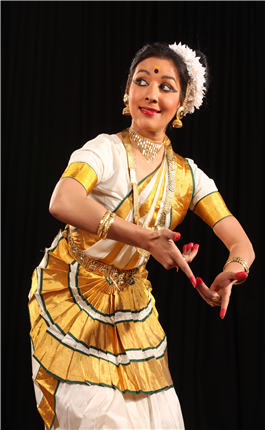 Dancer: Vijayalakshmi Dancer: Vijayalakshmi
Choreography: Bharati Shivaji
Composition and lyrics by Kavalam Narayana Panicker
Sung by Sadanam Radhakrishnan in Raga Begada followed by Poraneer set to Talamalika.
This item describes a peacock’s grief in not finding any sign of rain - a metaphor of the soul's yearning for liberation. The peacock prayers are soon answered when dark clouds gather. And when it rains, it seems like a marriage between heaven and earth. Nature rejoices, the young shoots sprout, while the cool breeze caresses. The peacock dances in ecstasy. |
| |
| Chakravaha Pallavi |
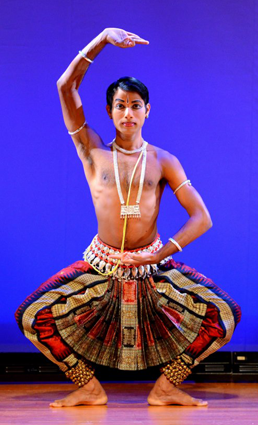 Dancer: Rahul Acharya Dancer: Rahul Acharya
Raga: Chakravaka Tala: Ektali
Choreography: Guru Durga Charan Ranbir
This dance forms the third chapter of the Odissi repertoire. Pallavi comes from the Sanskrit word Pallava, meaning a tender leaf. The dance begins with slow pulsating and accelerates as it goes on, taking the time to mature into a fully grown, adult tree swaying in the breeze
|
| |
| Kalbeliya |
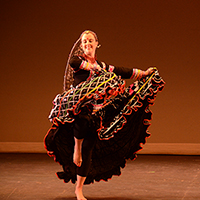 Dancers: Samarpita Bajpai, Kirstie McDermott and Krystal Bryan of Gurukul Dance Academy Dancers: Samarpita Bajpai, Kirstie McDermott and Krystal Bryan of Gurukul Dance Academy
Staging: Samarpita Bajpai, in collaboration with Jaisalmer Kalbeliya dancers.
Costumes, music developed in consultation with the Kalbeliyas from Jaisalmer.
This dance of the Kalbeliyas, a clan of snake charmers from the state of Rajasthan, is characterized by dizzying spins and serpentine movements.
|
| |
| Mayur Allaripu |
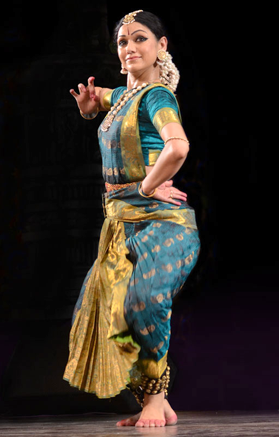 Dancer: Rama Vaidyanathan Dancer: Rama Vaidyanathan
Choreography: Rama Vaidyanathan
Music: Rhythmic syllables composed by K Sivakumar
This is an unusual Alarippu, in that the choreography combines the Alarippu structure of the traditional Bharatanatyam repertory with the motif of a peacock. Instead of the usual flat palm hand position (Pataka Hasta) this bird with a colorful tail is shown using the peacock hand position (Mayura Hasta).
|
| |
| Raas Lila (Bharatanatyam) |
Dancer: Rama Vaidyanathan
Choreography: Rama Vaidyanathan
Music: G. S. Rajan
Lyrics: medieval poet Soordas
When Krishna played his melodious flute, the young women of his village abandoned everything to join in this Dance of Love. The whole world was attracted to him. Animals and birds, including the peacock, swayed to his music. The Raas Leela gradually builds to a crescendo when the women surrender themselves completely to Krishna. Each one feels that Krishna is dancing only with her. The Leela symbolizes the play of Oneness with the many, that the Ultimate Being is everywhere. The dancer embodies the deep wish of human devotees to be united with that cosmic consciousness |
| |
| Nritta & Abhinaya |
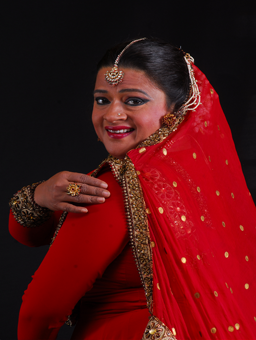 Dancer: Rani Khanam Dancer: Rani Khanam
Following the court traditions of Kathak, where there was an interactive relationship between dancer and sponsor/audience, Rani will share some techniques specific to the Lucknow style in a format that is different from that of concert dance. First she will show us different kinds of abstract, rhythmic dance patterns (Tukra, Paran, Parmelu, Ladi ...), then show us the same repertory performed with dramatic expression (Abhinaya). Through footwork and facial expression she might show raindrops falling, or imbue her movements with ideas like "searching" or "love". In this way, through a two-part presentation, Rani hopes to transport her audience into her Kathak world of spontaneous creativity and imagination.
|
| |
| Tarana Tillana (Kathak-Bharatanatyam Finale) |
Danced and conceived by Rani Khanam and Rama Vaidyanathan
Music: Ragamalika and Jhap Tala (cycle of 5 beats)
The finale of a Bharatanatyam recital is a pure dance 'Tillana', set to a musical composition that uses syllables like "ta-na-dheem" and which was derived from the north indian musical genre 'Tarana' which is performed in Kathak. The two dancers explore this relationship in a Bharatanaytam-Kathak 'conversational duet'. |
| |
| Audience participation led by Rahul and Vijayalakshmi.
|
| |
|
|
|
| The Indo-American Arts Council is a 501 ©3 not-for-profit secular arts organization passionately dedicated to promoting, showcasing and building an awareness of artists of Indian origin in the performing arts, visual arts, literary arts and folk arts. For information please visit www.iaac.us |
| |
|
|
Battery Dance Company's 32nd Annual Downtown Dance Festival
will take place in August 10-15, 2013. This year’s program is comprised of extraordinary domestic and international talents. Performances will showcase brilliant artistry from various nations around the globe, such as La Intrusa Danza (Spain), The Dance We Made (Great Britain) or José Limón Dance Company (New York City).
Based in Lower Manhattan, the festival will be held in its old and new locations, creating easy accessibility and an inviting atmosphere. The fusion of cultures and techniques will ultimately lead to a striking culmination of artistry.
|






